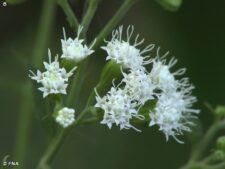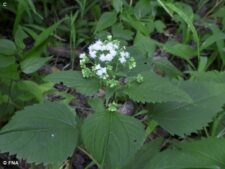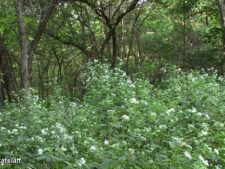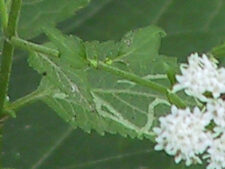
WHITE SNAKEROOT
Ageratina altissima
SUNFLOWER FAMILY (Asteraceae)
 Identification
Identification
- Flowering time - July, August, September
- Common in upland and floodplain woods at FF and NW
- Clusters of pure white flowers resembling tiny "snowballs"
- Opposite, broad, coarsely toothed leaves - sometimes with convoluted whitish lines
- Broad, stalked, toothed leaves separate it from several related species - see comments
This native perennial grows in clumps to 3 feet or more tall. The toothed, oval leaves with pointed tips, up to 6 inches long, have stalks which are arranged opposite on an erect stem (C). Leaf miners, larvae of a species of fly which feed on the leaf, are responsible for the convoluted whitish lines so often visible on their upper surface (E). Flowers are arranged in flat to dome-shaped clusters on long stalks originating at the point where the leaf stalks join the stem (leaf axil)(A,C). Each flower cluster contains several smaller flowerheads that look like miniature snowballs. Each of these “snowballs” contains from 10-30 tiny pure white disk florets (B). Seeds, each with its own small tuft of white hairs, form fluffy seed heads as the plant matures.
Common in upland and floodplain woodlands and woodland edges at Fontenelle Forest and Neale Woods, flowering from July through September.
White Snakeroot foliage contains a toxic alcohol called trematol. When ingested by cows, it appears in their milk, causing “milk sickness” in humans. This ailment claimed thousands of lives on the western frontier in the early 1800s. Abraham Lincoln’s mother is thought to have died from this disease when she was seven years old.
This plant does not have the showy ray flowers we find in many other members of the Sunflower Family. Rather, the tiny 5 petaled flowers we see are actually disk florets like those in the center of our yellow sunflowers that produce the actual seeds.
White Snakeroot flowers are similar to the following, but can be separated by their leaf structure: Tall Boneset (Eupatorium altissimum) has narrower, stalkless leaves with smooth margins. False Boneset (Brickellia eupatorioides) has much narrower, less prominently toothed, alternate leaves. Boneset (Eupatorium perfoliatum) has leaves which completely surround the stem.
The content of NatureSearch is provided by dedicated volunteer Naturalists of Fontenelle Forest who strive to provide the most accurate information available. Contributors of the images retain their copyrights. The point of contact for this page is: Roland Barth.




